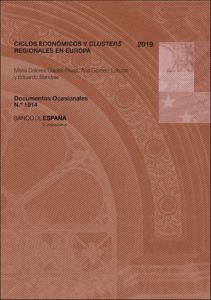Ciclos económicos y clusters regionales en Europa
Autor
Fecha de publicación
21-jun-2019
Descripción física
18 p.
Resumen
El análisis de los ciclos económicos de las regiones europeas pone de relieve la existencia de importantes asimetrías, que pueden esquematizarse en la configuración de distintos clusters caracterizados por patrones de comportamiento diferentes. La identificación de los distintos grupos debería revelar las singularidades territoriales que afronta cada país y, por tanto, la necesidad de complementar las políticas macroeconómicas comunes con otras dirigidas a atender situaciones específicas de carácter regional. El artículo muestra que la introducción del euro ha sido decisiva para aumentar la sincronización de los ciclos regionales, al tiempo que supuso una mayor distancia entre el grupo central de regiones europeas y los países que quedaron fuera de la moneda única. También resulta destacable que, a pesar del efecto del euro, se mantienen importantes singularidades entre las regiones alemanas, por una parte, y entre las de Grecia, Portugal e Italia, por otra.
The analysis of regional business cycles in Europe highlights the existence of a high degree of heterogeneity. However, clusters of regions that share similar behavior can be identifi ed. The identifi cation of these different groups should reveal territorial singularities that each country faces and, therefore, the need to complement the common macroeconomic policies with others aimed at addressing region-specifi c features specifi c. The paper shows that the introduction of the euro was key to increase the synchronization of regional business cycles, as it meant a greater distance between the central group of European regions and the countries that were left out of the single currency. It is also noteworthy that, despite the effect of the euro, important singularities remain between the German regions, on the one hand, and between those of Greece, Portugal and Italy, on the other.
The analysis of regional business cycles in Europe highlights the existence of a high degree of heterogeneity. However, clusters of regions that share similar behavior can be identifi ed. The identifi cation of these different groups should reveal territorial singularities that each country faces and, therefore, the need to complement the common macroeconomic policies with others aimed at addressing region-specifi c features specifi c. The paper shows that the introduction of the euro was key to increase the synchronization of regional business cycles, as it meant a greater distance between the central group of European regions and the countries that were left out of the single currency. It is also noteworthy that, despite the effect of the euro, important singularities remain between the German regions, on the one hand, and between those of Greece, Portugal and Italy, on the other.
Publicado en
Documentos Ocasionales / Banco de España, 1914
Materias
Datado del ciclo económico; Regiones; Modelos de Markov con mixturas finitas de distribuciones; Business cycle dating; Regions; Finite mixture Markov models; Fluctuaciones y ciclos económicos; Integración económica europea; Economía regional y recursos naturales; Países de la UE
Aparece en las colecciones:












